History
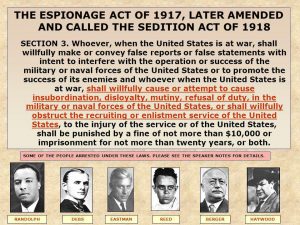 It seems strange to me to create a piece of legislation that protects the government and the war effort from…basically hate speech, but on May 16, 1918, the United States Congress did pass just such an act. What seems even more strange is to have a need for such a piece of legislation during a time of war. Called the Sedition Act, a piece of legislation designed to protect America’s participation in World War I. Along with the Espionage Act of the previous year, the Sedition Act was orchestrated largely by A. Mitchell Palmer, the United States attorney general under President Woodrow Wilson. I think most of us understand espionage, and why such an act was important to the war effort. The Espionage Act, passed shortly after the US entrance into the war in early April 1917, made it a crime for any person to convey information intended to interfere with the U.S. armed forces’ prosecution of the war effort or to promote the success of the country’s enemies.
It seems strange to me to create a piece of legislation that protects the government and the war effort from…basically hate speech, but on May 16, 1918, the United States Congress did pass just such an act. What seems even more strange is to have a need for such a piece of legislation during a time of war. Called the Sedition Act, a piece of legislation designed to protect America’s participation in World War I. Along with the Espionage Act of the previous year, the Sedition Act was orchestrated largely by A. Mitchell Palmer, the United States attorney general under President Woodrow Wilson. I think most of us understand espionage, and why such an act was important to the war effort. The Espionage Act, passed shortly after the US entrance into the war in early April 1917, made it a crime for any person to convey information intended to interfere with the U.S. armed forces’ prosecution of the war effort or to promote the success of the country’s enemies.
The Sedition Act was aimed at socialists, pacifists and other anti-war activists. The Act imposed harsh penalties on anyone who was found guilty of making false statements that interfered with the prosecution of the war; insulting or abusing the United States government, the flag, the Constitution or the military; agitating against the production of necessary war materials; or advocating, teaching or defending any of these acts. Hmmm…I think we have need of this act in today’s America. Those who were found guilty of such actions, would according to the Sedition Act be punished by a fine of not more than $10,000 or imprisonment for not more than twenty years, or both. The penalty was the same as the one for acts of espionage in the earlier legislation.
Though Wilson and Congress considered the Sedition Act as crucial in order to stifle the spread of dissent within the country in that time of war, modern legal scholars felt the act was contrary to the letter and spirit of the US Constitution, specifically to the First Amendment of the Bill of Rights. One of the most famous prosecutions under the Sedition Act during World War I was that of Eugene V. Debs, a pacifist labor organizer and founder of the International Workers of the World (IWW Debs had run for president in 1900 as a Social Democrat and in 1904, 1908 and 1912 on the Socialist Party of America ticket. He delivered an anti-war speech in June 1918 in Canton, Ohio and was promptly arrested. After being found guilty, he was sentenced to ten years in prison under the Sedition Act. Debs appealed the decision and upon stating that Debs had acted with the intention of obstructing the war effort the US Supreme Court upheld his conviction.
Chief Justice Oliver Wendell Holmes referred to the earlier landmark case of Schenck v. United States (1919) as the basis for his decision. Charles Schenck, also a Socialist, had been found guilty under the Espionage Act after distributing a flyer urging recently drafted men to oppose the United States conscription policy. Holmes stated that freedom of speech and press could be constrained in certain instances. He said that the question in every case is “whether the words used are used in such circumstances and are of such a nature as to create a clear and present danger that they will bring about the substantive evils that Congress has a right to prevent.”
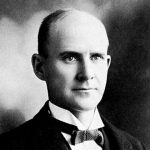
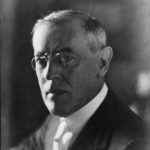
Debs’ sentence was commuted in 1921 when the Sedition Act was repealed by Congress. Major portions of the Espionage Act remain part of United States law to the present day, although the crime of sedition was largely eliminated by the famous libel case Sullivan v. New York Times (1964), which determined that “the press’s criticism of public officials—unless a plaintiff could prove that the statements were made maliciously or with reckless disregard for the truth—was protected speech under the First Amendment.”

 As a kid, I remember that whenever we were sitting at an intersection that was very busy, causing us to have to wait seemingly forever to be able to get across the intersection, one of my parents would say something like, “Wow!! Who opened the floodgates?” Of course, I didn’t know what a floodgate was then, and I just thought they were referring to a flood of vehicles, which they were, and they probably didn’t think about what a real floodgate was either. It was just a funny saying to us, but in reality, a floodgate is a very important flood preventative tool. I guess that our version of floodgates meant the same thing, except in vehicles and not in water.
As a kid, I remember that whenever we were sitting at an intersection that was very busy, causing us to have to wait seemingly forever to be able to get across the intersection, one of my parents would say something like, “Wow!! Who opened the floodgates?” Of course, I didn’t know what a floodgate was then, and I just thought they were referring to a flood of vehicles, which they were, and they probably didn’t think about what a real floodgate was either. It was just a funny saying to us, but in reality, a floodgate is a very important flood preventative tool. I guess that our version of floodgates meant the same thing, except in vehicles and not in water.
On May 15, 2011, the United States Army Corps of Engineers opened the floodgates in the state of Louisiana along the Mississippi river. This was an effort to save larger cities located along the Mississippi, like Baton Rouge and New Orleans, from flooding. The Mississippi was already heading for critical stages, and it was only expected to get worse. The flooding was expected to cover up to three thousand square miles, and it had the potential to affect up to 25,000 people. This was the first time in forty years that the river levels have forced the opening of the floodgates. I don’t know how often floodgates are utilized in other areas to prevent flooding, but when people live in flood prone areas, they have to use whatever mean necessary to protect themselves and their property from damage and death.
The Mississippi River floods in April and May 2011 were among the largest and most damaging recorded along that river in the past century. The flood was comparable in extent to the major floods of 1927 and 1993. From April 14–16, the storm system that was responsible for one of the largest tornado outbreaks in US history also produced large amounts of rainfall across the southern and midwestern United States. Then two more storm systems, each with heavy rain and tornadoes, hit in the third week of April. In the fourth week of April, from April 25–28, another and even more extensive and deadly storm system passed through the Mississippi Valley dumping more rainfall resulting in deadly flash floods. The unprecedented extensive rainfall from these four storms, combined with springtime snow melt from the Upper Midwest, created the perfect conditions for a 500-year flood along the Mississippi.
The purpose of opening the floodgates was to take some of the pressure off of the levees, in the hope of preventing the breech of the levees. Most of the time, it works pretty well, like when the city of Casper, Wyoming, where I live opens up the gates at the area lakes and while the river runs high for a time, there are 
 very few places where it spills over the bank. Unfortunately, the Mississippi river still spilled over its banks, and broke levees. I don’t think anyone could have really prevented the monster floods that hit the area in 2011, or even in 1927 or 1933, but they couldn’t focus on that right then, because they had to do whatever they could to prevent. In the end, the flood came and the damage was done.
very few places where it spills over the bank. Unfortunately, the Mississippi river still spilled over its banks, and broke levees. I don’t think anyone could have really prevented the monster floods that hit the area in 2011, or even in 1927 or 1933, but they couldn’t focus on that right then, because they had to do whatever they could to prevent. In the end, the flood came and the damage was done.
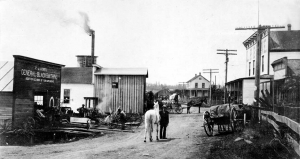
 I first heard about Oak Harbor, Washington when my sister, Caryl Reed and her then husband lived there while he was stationed at the nearby naval station at Whidbey Island. Now that my daughter, Amy Royce, her husband Travis and their kids Shai and Caalab live in the Bellingham area of upstate Washington, Oak Harbor has once again come into range of my radar. Oak Harbor was founded in the 1850s when three settlers staked claims where the city now stands. Martin Taftezon, a shoemaker from Norway; C.W. Sumner from New England; and Ulrich Freund, a Swiss Army officer. Freund retained part of his claim, which today is home to his descendants. The city was incorporated on May 14, 1915, and celebrated it’s 100th anniversary in 2015.
I first heard about Oak Harbor, Washington when my sister, Caryl Reed and her then husband lived there while he was stationed at the nearby naval station at Whidbey Island. Now that my daughter, Amy Royce, her husband Travis and their kids Shai and Caalab live in the Bellingham area of upstate Washington, Oak Harbor has once again come into range of my radar. Oak Harbor was founded in the 1850s when three settlers staked claims where the city now stands. Martin Taftezon, a shoemaker from Norway; C.W. Sumner from New England; and Ulrich Freund, a Swiss Army officer. Freund retained part of his claim, which today is home to his descendants. The city was incorporated on May 14, 1915, and celebrated it’s 100th anniversary in 2015.
When we visited Caryl, she took us to see one of the prettiest places in the area, known as Deception Pass. You might wonder why it is called Deception Pass. The Pass is actually a strait between the Whidbey and the Fidalgo Islands and is called “Deception” because George Vancouver was mislead by it into thinking that Whidbey Island was a peninsula. However it came to be, Deception Pass, the area is beautiful. There is also a series of 25 trails in the Deception State Park that I am interested in. I am hoping to be able to hike the area on our next visit to see our daughter and her family.
The town of Oak Harbor is Whidbey Island’s largest incorporated city. It is located in Island County. Oak Harbor was named for the Garry Oak trees which grace its skyline. The growth of Oak Harbor was really brought on by 
 two events…the building of Deception Pass Bridge on July 31, 1935, and the completion of Naval Air Station Whidbey Island on September 21, 1942. After that, Oak Harbor grew from a population of 362 in 1935, to 22,954 in 2018. I enjoyed our visit when my sister lived there, and even though our daughter lives further north, Oak Harbor is not too far away for a visit and maybe a hike.
two events…the building of Deception Pass Bridge on July 31, 1935, and the completion of Naval Air Station Whidbey Island on September 21, 1942. After that, Oak Harbor grew from a population of 362 in 1935, to 22,954 in 2018. I enjoyed our visit when my sister lived there, and even though our daughter lives further north, Oak Harbor is not too far away for a visit and maybe a hike.
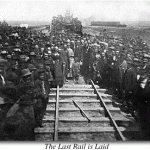 These days we don’t usually think much about trains as a form of transportation, but in 1869, they were the latest in modern travel. The United States is a large country, and it took months to travel across it with a horse drawn wagon. Travel was so time consuming, that most people could not take the necessary time off from their jobs and lives to go to visit family that had moved west, or those who stayed in the east. Enter the train.
These days we don’t usually think much about trains as a form of transportation, but in 1869, they were the latest in modern travel. The United States is a large country, and it took months to travel across it with a horse drawn wagon. Travel was so time consuming, that most people could not take the necessary time off from their jobs and lives to go to visit family that had moved west, or those who stayed in the east. Enter the train.
Trains could take people to far away destinations much faster, and cheaper…but there was still one problem…train tracks. The trains could only go as far as the tracks did, and the work of building tracks was a back breaking job. Nevertheless, 150 years ago, on this day, May 10, 1869, the presidents of the Union Pacific and Central Pacific railroads meet in Promontory, Utah. There they drove a ceremonial last spike into a rail line that connects their railroads. This made transcontinental railroad travel possible for the first time in United States history.

Now 150 years later, on of the trains that rode those rails in those days is back on the rails. The locomotives were called “Big Boys” and they certainly were. “It’s longer than two city buses, weighs more than a Boeing 747 fully loaded with passengers and can pull 16 Statues of Liberty over a mountain.” The refurbished Big Boy is the number 4014 steam locomotive that rolled out of a Union Pacific restoration shop in Cheyenne this past weekend for a big debut after five years of restoration. It then headed toward Utah as part of a yearlong tour to commemorate the Transcontinental Railroad’s 150th anniversary. If you have a chance, I would highly recommend that you get a copy of the schedule and plan to go see it. We are planning to, for sure.
 When we think of heroes during the Nazi years, we think mostly of men, but there were a few women who were real heroes too. One such woman, Sophia Magdalena Scholl, who was born on May 9, 1921, was a German student, who was also a serious anti-Nazi political activist. She was active within the White Rose non-violent resistance group in Nazi Germany. Scholl was the fourth of six children born to Magdalena (Müller) and liberal politician and ardent Nazi critic Robert Scholl. Her father was the mayor of her hometown of Forchtenberg am Kocher in the Free People’s State of Württemberg, at the time of her birth.
When we think of heroes during the Nazi years, we think mostly of men, but there were a few women who were real heroes too. One such woman, Sophia Magdalena Scholl, who was born on May 9, 1921, was a German student, who was also a serious anti-Nazi political activist. She was active within the White Rose non-violent resistance group in Nazi Germany. Scholl was the fourth of six children born to Magdalena (Müller) and liberal politician and ardent Nazi critic Robert Scholl. Her father was the mayor of her hometown of Forchtenberg am Kocher in the Free People’s State of Württemberg, at the time of her birth.
Scholl was brought up in the Lutheran church. She entered junior or grade school at the age of seven, and was considered an intelligent child who learned easily. Her childhood was a happy and carefree one. In 1930, the family moved to Ludwigsburg and then two years later to Ulm where her father had a business consulting office. These were definitely the best years of her life.
In 1932, after Scholl started attending a secondary school for girls, at the age of twelve, she chose to join the Bund Deutscher Mädel (League of German Girls), as did most of her classmates. It was as common as joining the girl scouts was in the United States. Her initial enthusiasm gradually gave way to criticism. She was aware of the dissenting political views of her father, friends, and some teachers. Even her own brother Hans, who once eagerly participated in the Hitler Youth program, became entirely disillusioned with the Nazi Party. Sophia was quickly learning of the horrors of Hitler and his Nazi regime. Political attitude had become an essential criterion in her choice of friends. The arrest of her brothers and friends in 1937 for participating in the German Youth Movement left a strong impression on her.
In 1943, with the Nazi movement in full swing, Sophia and her brother, Hans were at the University of Munich distributing anti-war leaflets when they were arrested and charged with high treason. Of course, handing out  anti-war leaflets in the United States would never be considered cause for a high treason conviction, but then Sophia and her brother did not live in the United States. In the People’s Court before Judge Roland Freisler on 22 February 1943, Scholl was recorded as saying these words, “Somebody, after all, had to make a start. What we wrote and said is also believed by many others. They just don’t dare express themselves as we did.” There was no testimony allowed for the defendants; this was their only defense. The brother and sister were subsequently convicted of the high treason charges, and as a result, were executed by guillotine on February 22, 1943. Since the 1970s, Scholl has been extensively commemorated for her anti-Nazi resistance work.
anti-war leaflets in the United States would never be considered cause for a high treason conviction, but then Sophia and her brother did not live in the United States. In the People’s Court before Judge Roland Freisler on 22 February 1943, Scholl was recorded as saying these words, “Somebody, after all, had to make a start. What we wrote and said is also believed by many others. They just don’t dare express themselves as we did.” There was no testimony allowed for the defendants; this was their only defense. The brother and sister were subsequently convicted of the high treason charges, and as a result, were executed by guillotine on February 22, 1943. Since the 1970s, Scholl has been extensively commemorated for her anti-Nazi resistance work.
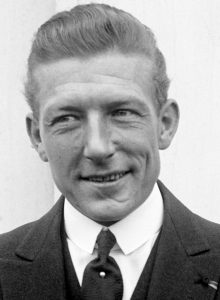
 It was a time when the race across the Atlantic Ocean was a big as the Race to Space would become years later. Since the invention of planes, everyone trained as a pilot wanted to set some sort of record in the aviation industry, and there were plenty of them out there to set. One in particular, the transatlantic flight was in its early stages. The world was waiting for that first successful transatlantic non-stop flight.
It was a time when the race across the Atlantic Ocean was a big as the Race to Space would become years later. Since the invention of planes, everyone trained as a pilot wanted to set some sort of record in the aviation industry, and there were plenty of them out there to set. One in particular, the transatlantic flight was in its early stages. The world was waiting for that first successful transatlantic non-stop flight.
Then on May 8, 1927, it looked like all that would change. That morning French aviator, Captain Charles Nungesser and his co-pilot, Francis Coli took off from Paris in a plane they called The White Bird, to the surprise of many observers who felt the weather conditions were not favorable. Nevertheless, the White Bird taxied down the runway at 5:17 am on that Sunday morning, bound for New York. The plane rose and faltered, and after rolling half a mile it finally labored into the air. As it disappeared in the distance, it was no more than 700 feet off the ground when. Less than five hours later the White Bird was sighted leaving the Irish coast on its way westward over the Atlantic. It looked as if all was going well.
The Bi-Plane was later spotted in the early morning off Nova Scotia fighting strong head winds and heading for the Maine Seaboard. It had been in the air for approximately 33 hours. Shortly after the sighting the plane mysteriously disappeared while trying to be the first to complete the non-stop transatlantic flight, flying from Paris to New York City. On the afternoon of May 9, 1927, Anson Berry, fishing in his canoe on Round Lake in eastern Maine, heard what sounded like an engine overhead, approaching from the northeast. He could not see the airplane, if that was what it was, because of a heavy overcast. He assumed that it was the White Bird, because there weren’t many planes flying in those days.
The engine sounded erratic. Moments later it stopped, and Berry heard what he described years later as a faint, 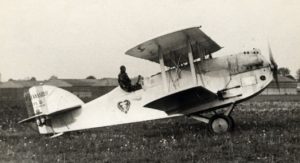 ripping crash. The afternoon was wearing on, and the always unsteady spring weather was worsening, with rain beginning to fall. Perhaps because he did not trust the weather to hold, Berry did not investigate what he heard. The plane, pilot and navigator have never been seen since and two weeks later American aviator Charles Lindbergh, flying solo, successfully crossed from New York to Paris. Many people wondered why no one had ever happened upon the wreck, but the probable area of the crash is in an area of heavy underbrush, and it is likely that the wreck has been buried in the foliage.
ripping crash. The afternoon was wearing on, and the always unsteady spring weather was worsening, with rain beginning to fall. Perhaps because he did not trust the weather to hold, Berry did not investigate what he heard. The plane, pilot and navigator have never been seen since and two weeks later American aviator Charles Lindbergh, flying solo, successfully crossed from New York to Paris. Many people wondered why no one had ever happened upon the wreck, but the probable area of the crash is in an area of heavy underbrush, and it is likely that the wreck has been buried in the foliage.
 In the year 1840, there was no such thing as the Fujita Scale, so when Natchez, Mississippi was hit by an F4 or F5 tornado on May 7, 1840, nobody knew its exact size, just that it was big…very big. Natchez in 1840 was a typical southern river town, reminiscent of the pre-Civil War days of slave labor and plantation wealth. Many people believed that nothing in their little part of the world could possibly change, and certainly not because of the weather. This was the context into which this tornado was about to enter…screaming violently.
In the year 1840, there was no such thing as the Fujita Scale, so when Natchez, Mississippi was hit by an F4 or F5 tornado on May 7, 1840, nobody knew its exact size, just that it was big…very big. Natchez in 1840 was a typical southern river town, reminiscent of the pre-Civil War days of slave labor and plantation wealth. Many people believed that nothing in their little part of the world could possibly change, and certainly not because of the weather. This was the context into which this tornado was about to enter…screaming violently.
May 7th started out hot and muggy, with overcast skies. The clouds were thick and most of that morning they produced continual rumblings of thunder. One resident recalled that the temperatures were in the mid-60s. Nothing about the day led anyone to believe that they were in eminent danger. And of course, at that time, there were no warning sirens, so the day dragged lazily along. At about 2 pm, the sky darkened so much that candles were needed to finish the mid-day meal that many were eating. The tornado touched down about 20 miles southwest of Natchez and moved in a northeasterly direction. It is believed that the tornado was rain-wrapped, because residence described it as “black masses, some stationary and some whirling” but the storm caused “no particular alarm” amongst the residents of Natchez. Most of the residents who weren’t eating dinner, were working down by the river. Dr Henry Tooley noted that the barometer began to fall rapidly, followed by the rain and then the tornado.
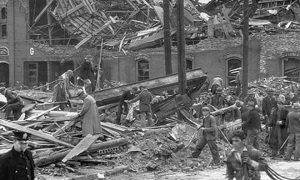
At about 2:10 pm the tornado screamed into Natchez. It lasted about three to five minutes, but the storm itself lasted about 30 minutes before it blew itself out of town. The damage path was about 10 miles long, and was estimated to be between one and two miles wide. For a time, it followed the Mississippi River hitting the southern and eastern edges of the town of Vidalia. Then the tornado crossed the river and continued on into Natchez. The town of Natchez was virtually wiped of the map, and the people on boats on the river were in serious trouble. Most of the boats on the river were flatboats, which were large rafts that carried goods on one-way trips down to New Orleans to be sold. Of the 120 flatboats docked at Natchez, 116 of them sunk. The unofficial estimated death toll was that as many as 200 people drowned after being tossed from their flatboats. It was said that “during the tornado the water rose between 10 and 15 feet, and that the water was whipped to such an extent where even a experienced swimmer could not sustain themselves on the surface.” There were also steamers one of which, The Prairie was ironically filled with a cargo of lead at the time. It sunk, of course. The steamer Hinds was badly damaged but did not sink. Its lifeless remains floated down the river to Baton Rouge where 51 bodies were found aboard.
It was really hard to establish an accurate death count, because most of the people on the river in Natchez 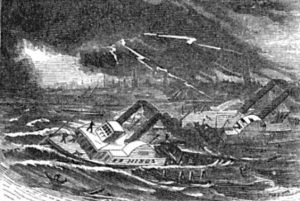 were not from Natchez. Most of the bodies that were found…those which were not lost after they floated out to sea…were unable to be identified because no-one knew who they were or where they came from. Lloyd’s Steamboat Disasters lists the number of lives lost that day at around 4004. In reality, this number was likely way off. This was a significant tornado, however damage also occurred above the river, in Natchez itself. The death toll may have also been skewed because in those days, the slaves were not always counted in census or death tolls. Either way, the Natchez tornado of 1840 ranks as the second most deadly tornado in US history, behind the Tri-State Tornado of 1925.
were not from Natchez. Most of the bodies that were found…those which were not lost after they floated out to sea…were unable to be identified because no-one knew who they were or where they came from. Lloyd’s Steamboat Disasters lists the number of lives lost that day at around 4004. In reality, this number was likely way off. This was a significant tornado, however damage also occurred above the river, in Natchez itself. The death toll may have also been skewed because in those days, the slaves were not always counted in census or death tolls. Either way, the Natchez tornado of 1840 ranks as the second most deadly tornado in US history, behind the Tri-State Tornado of 1925.
 The leaders of wars have long been known for their means of deception. They will try whatever they can to confuse the enemy, and thus make their own troops safer. It all seems like a good idea, until it all goes wrong. Such was the case when, during World War I, the British army decided to disguise a passenger ship…the RMS Carmania into a battleship disguised as another passenger ship…the German SMS Trafalgar.
The leaders of wars have long been known for their means of deception. They will try whatever they can to confuse the enemy, and thus make their own troops safer. It all seems like a good idea, until it all goes wrong. Such was the case when, during World War I, the British army decided to disguise a passenger ship…the RMS Carmania into a battleship disguised as another passenger ship…the German SMS Trafalgar.
Now that all seems like a good plan, provided that you don’t run into the real SMS Trafalgar…or someone who knows where the real SMS Trafalgar is at that moment. The plan was working well, and the RMS Carmania/SMS Trafalgar seemed a great success. The only problem was that the Germans had the same idea. They decided to disguise the SMS Trafalgar as the RMS Carmania. It is odd that each side chose the ship that the other had disguised, and when you think about it, it was clearly a recipe for disaster. It was only a matter of time before the two ships would run into each other, each knowing that the other was an imposter, but not knowing that their enemy knew the same thing.
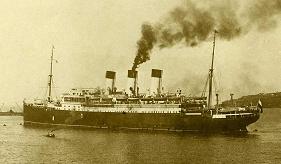
The unavoidable encounter came on September 14, 1914. A fierce battle ensued, and in the end, it was the SMS Trafalgar turned RMS Carmania that would ultimately lose this battle. In all, 51 men were killed and 279 injured from the real SMS Trafalgar, while the real RMS Carmania suffered just 9 losses. The SMS Trafalgar was also lost in the encounter. While the real RMS Carmania suffered repairable damage. The battle and ultimate sinking of the SMS Trafalgar took place off the coast of Brazil. I find it quite ironic that each ship was trying to hide in plain sight, and ended up in a battle with the very ship it was disguised to look like.
 These days, organ transplants are a fairly common event. It’s not that everyone is having them, but that many people who need one get it. Years ago, something like a failing liver was an instant death sentence. The doctors would try to find a way to heal the liver, but they knew that it was not likely to happen. I know that it was heartbreaking for the doctors, who became doctors to save lives, not to lose them.
These days, organ transplants are a fairly common event. It’s not that everyone is having them, but that many people who need one get it. Years ago, something like a failing liver was an instant death sentence. The doctors would try to find a way to heal the liver, but they knew that it was not likely to happen. I know that it was heartbreaking for the doctors, who became doctors to save lives, not to lose them.
The real game changer came in 1963, when Dr Thomas E Starzl of Denver, Colorado, performed the first successful liver transplant in history. The patient was a 48 year old man. Unfortunately, he only lived for 22 day, but in those 22 days, a door was opened. Yes, there were problems, and the patient died, but he also lived…with a liver that wasn’t originally his. That was a huge step in the transplant game, and because of that step, Starzl became known as “the father of modern transplantation.”
Between March 1 and October 4, 1963, Starzl attempted 5 human liver replacements. The first patient bled to death during the operation. The other 4 died after 6.5 to 23 days. The autopsies didn’t show rejection, but rather that the patients died of site infections. During this time, there were also single attempts at transplant,  Francis D. Moore in September 1963 in Boston, and Demirleau in January 1964 in Paris. None were considered successful, but as I said. I would disagree, because while the patients died, they also lived. At this point, liver transplants on humans stopped until the summer of 1967. The operation was thought to be too difficult to ever be tried again, but Starzl refused to give up, and in 1967, he performed the first successful human liver transplant, at the University of Colorado Health Sciences Center. This one would be even be considered a success by Starzl. He had also performed the world’s first spleen transplant four months earlier in the same year. After that, transplants became everyday operations.
Francis D. Moore in September 1963 in Boston, and Demirleau in January 1964 in Paris. None were considered successful, but as I said. I would disagree, because while the patients died, they also lived. At this point, liver transplants on humans stopped until the summer of 1967. The operation was thought to be too difficult to ever be tried again, but Starzl refused to give up, and in 1967, he performed the first successful human liver transplant, at the University of Colorado Health Sciences Center. This one would be even be considered a success by Starzl. He had also performed the world’s first spleen transplant four months earlier in the same year. After that, transplants became everyday operations.
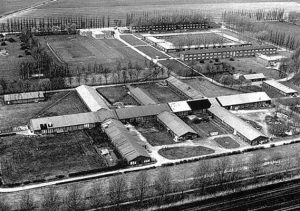 The Neuengamme concentration camp was established in December 1938, and used by the Nazis as a forced labor camp from December 13, 1938 to May 4, 1945, when it was liberated by British troops. At the time of its liberation, about half of the approximately 106,000 Jews held there over time had died. Neuengamme was located on the Elbe river, near Hamburg, Germany. One hundred inmates who were transferred from Sachsenhausen concentration camp, were forced to build the Neuengamme concentration camp. It was established around an empty brickworks in Hamburg-Neuengamme. The bricks produced there were to be used for the “Fuehrer buildings” part of the National Socialists’ redevelopment plans for the river Elbe in Hamburg.
The Neuengamme concentration camp was established in December 1938, and used by the Nazis as a forced labor camp from December 13, 1938 to May 4, 1945, when it was liberated by British troops. At the time of its liberation, about half of the approximately 106,000 Jews held there over time had died. Neuengamme was located on the Elbe river, near Hamburg, Germany. One hundred inmates who were transferred from Sachsenhausen concentration camp, were forced to build the Neuengamme concentration camp. It was established around an empty brickworks in Hamburg-Neuengamme. The bricks produced there were to be used for the “Fuehrer buildings” part of the National Socialists’ redevelopment plans for the river Elbe in Hamburg.
The prisoners worked on the construction of the camp and brickmaking. The bricks were used for regulating the flow of the Dove-Elbe river and the building of a branch canal. The prisoners were also 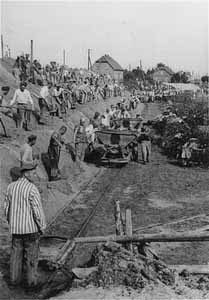 used to mine the clay used to make the bricks. That reminds me of the Jews in Egypt who were forced to build the pyramids. In 1940, the population of the camp was 2,000 prisoners, with a proportion of 80% German inmates among them. Between 1940 and 1945, more than 95,000 prisoners were incarcerated in Neuengamme. On April 10th, 1945, the number of prisoners in the camp itself was 13,500. Over the years that Neuengamme was open, it is estimated that 103,000 to 106,000 people were held there. We may never really know, because they didn’t keep clear records of all the people who went through the camps.
used to mine the clay used to make the bricks. That reminds me of the Jews in Egypt who were forced to build the pyramids. In 1940, the population of the camp was 2,000 prisoners, with a proportion of 80% German inmates among them. Between 1940 and 1945, more than 95,000 prisoners were incarcerated in Neuengamme. On April 10th, 1945, the number of prisoners in the camp itself was 13,500. Over the years that Neuengamme was open, it is estimated that 103,000 to 106,000 people were held there. We may never really know, because they didn’t keep clear records of all the people who went through the camps.
From 1942 on, the inmates were forced to work in the Nazi armament production. At first, the work was performed in the Neuengamme workshops, but soon it was decided to transfer the prisoners to the armaments factories in the surroundings areas. At the end of the war, the prisoners of Neuengamme were spread all over northern Germany. As the Allied troops advanced, hundreds of inmates were forced to dig antitank ditches. In many large north German cities, The prisoners were also require to clear rubble and removed corpses after bombing raids. There were 96 sub-camps, 20 of them for women. In early spring 1945, more than 45,000 inmates were working for the Nazi industry. A third of the women were forced to be among a part of the Nazi 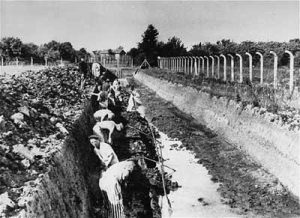 industry workforce. By this time, the internal population of Neuengamme was 13,500, which made it completely overcrowded. The estimated number of victims in Neuengamme is approximately 56,000. Thousands of inmates were hanged, shot, gassed, killed by lethal injection or transferred to the death camps Auschwitz and Majdanek. As the war neared its end, the SS decided to evacuate Neuengamme. They had hoped to avoid having them liberated…probably hoping to regroup further north. This was the start of one of the worst death marches of the war. During these death marches, approximately 10,000 inmates perished by shootings or simply starvation. Nevertheless, the Allies won this war, and then they went in and liberated the prisoners of the many death camp.
industry workforce. By this time, the internal population of Neuengamme was 13,500, which made it completely overcrowded. The estimated number of victims in Neuengamme is approximately 56,000. Thousands of inmates were hanged, shot, gassed, killed by lethal injection or transferred to the death camps Auschwitz and Majdanek. As the war neared its end, the SS decided to evacuate Neuengamme. They had hoped to avoid having them liberated…probably hoping to regroup further north. This was the start of one of the worst death marches of the war. During these death marches, approximately 10,000 inmates perished by shootings or simply starvation. Nevertheless, the Allies won this war, and then they went in and liberated the prisoners of the many death camp.

